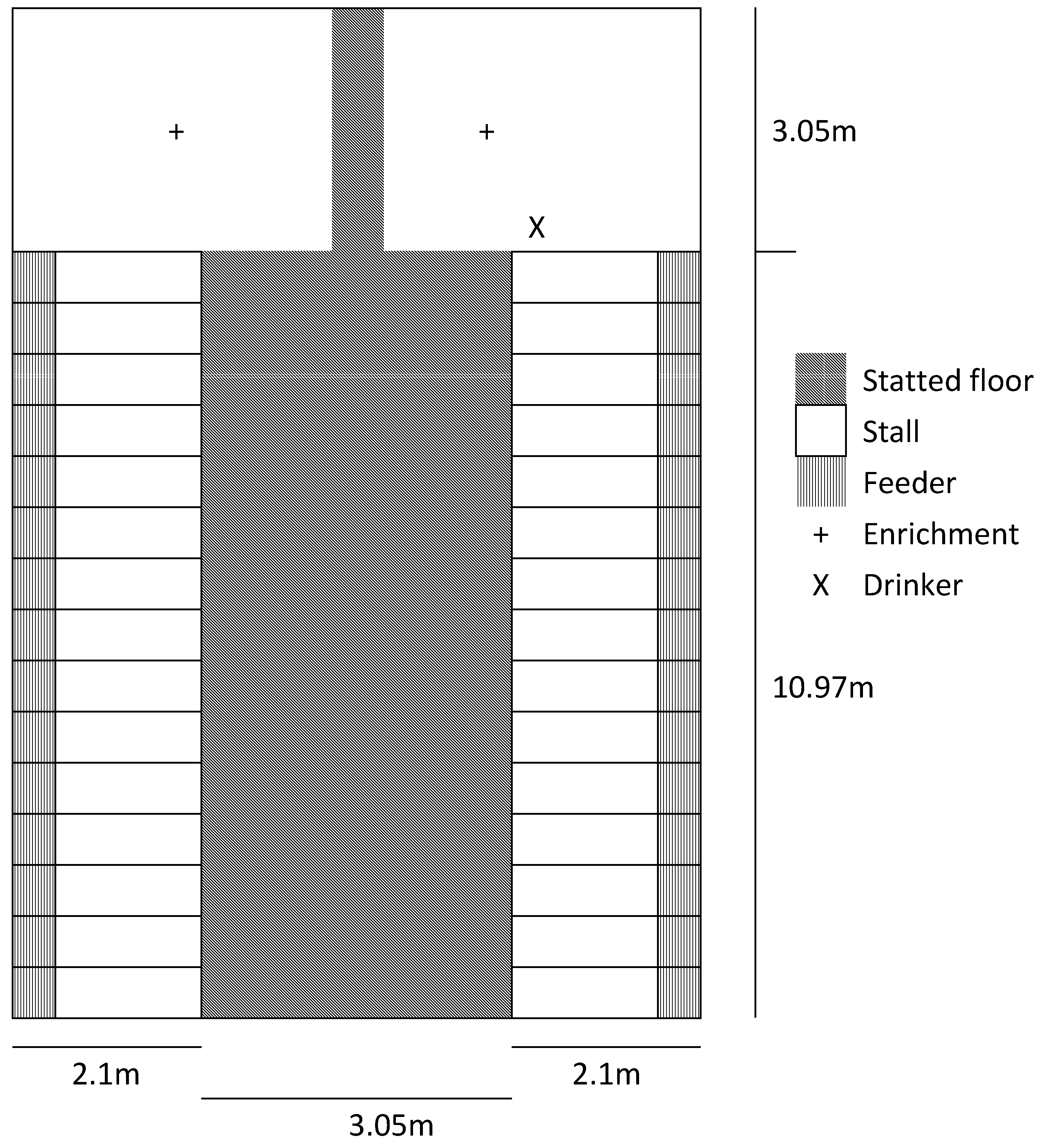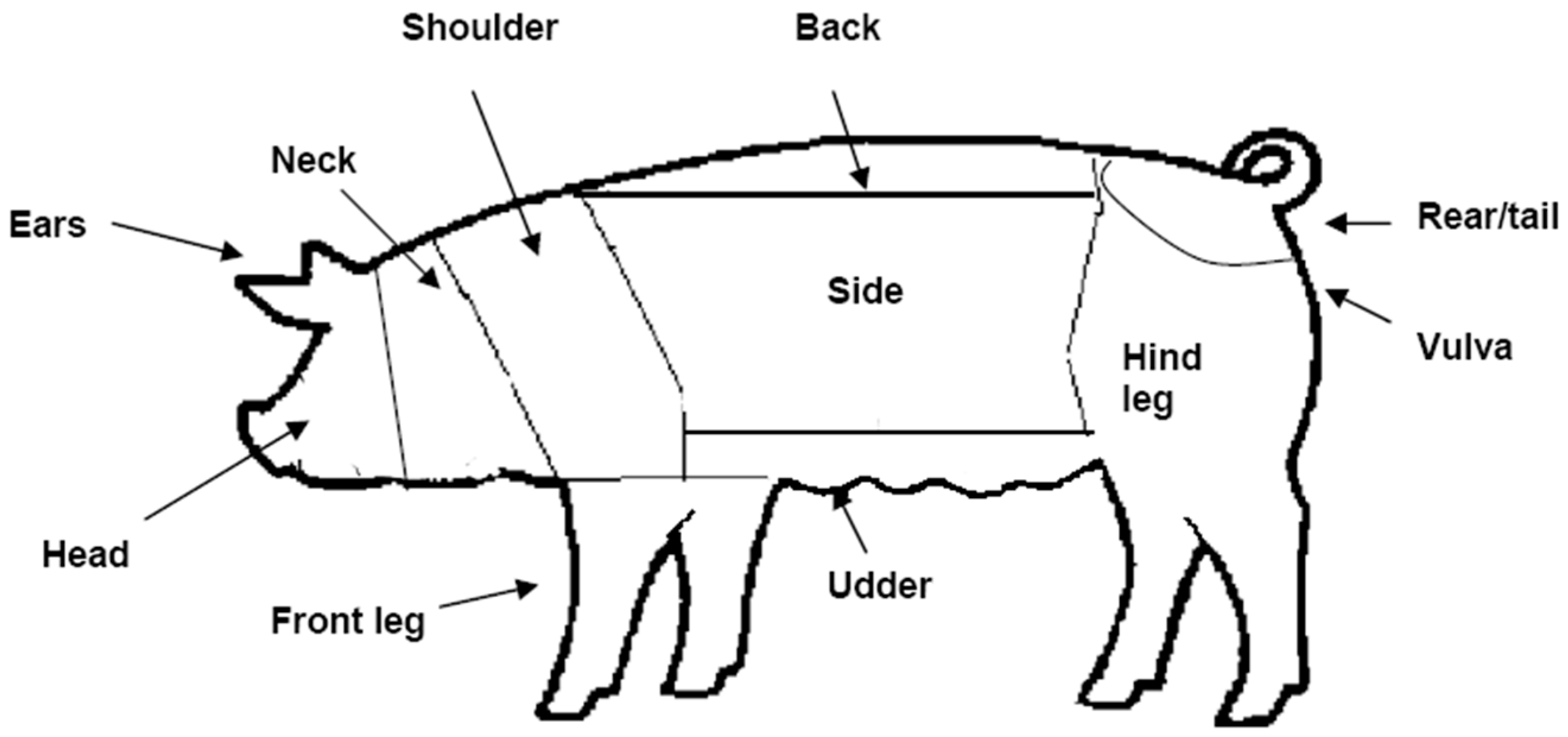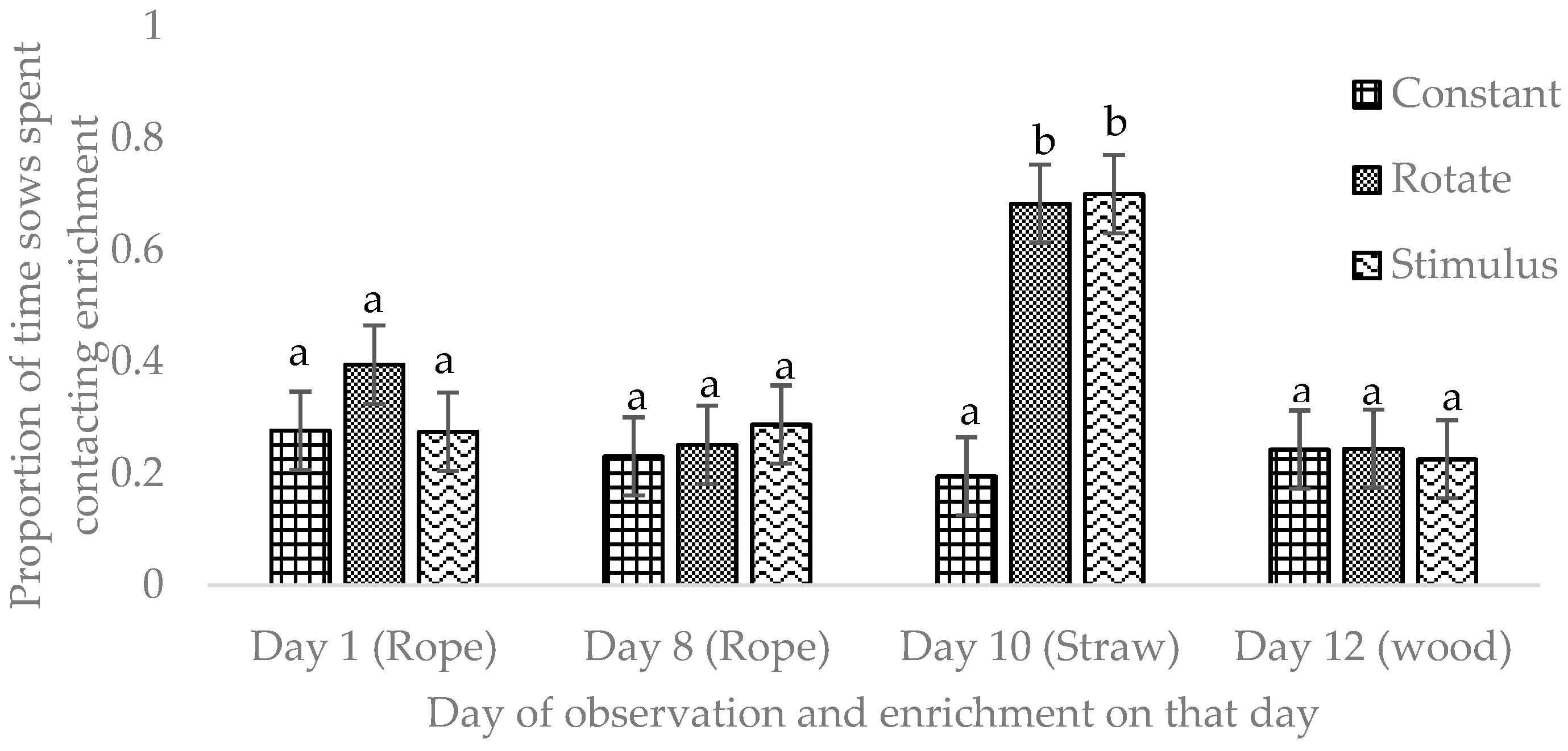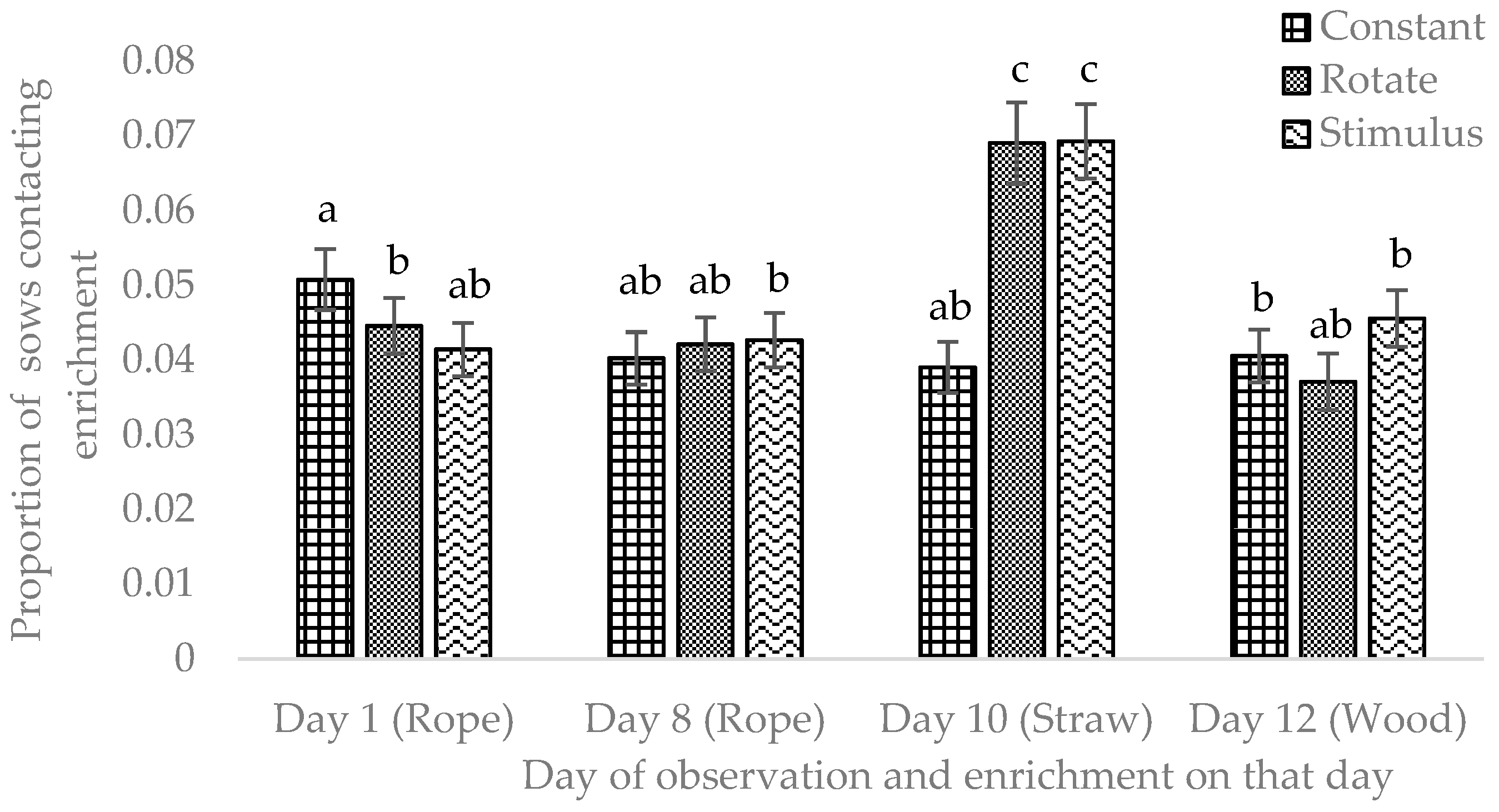1. Introduction
Group housing is becoming more common on North American farms. Sows in these systems have welfare benefits such as increased freedom to move and social enrichment through interaction with other sows. However, the success of group housing depends on space availability and the presence of an appropriate feeding system. An added advantage of group housing is the increased opportunity to introduce enrichment and improve pig health and welfare [
1]. Several studies indicate that enrichment increases social and overall activity [
2,
3]. In growing pigs, enrichment has been found to increase adaptability to novelty and learning capabilities, as well as reduce tail and ear biting, belly nosing, and fear [
1,
4,
5,
6,
7,
8,
9].
In North America, the use of substrate enrichments is generally avoided due to their potential for blocking the slurry system associated with slatted floors [
4]. In contrast, enrichment materials that are fixed to specific positions in the pen (point source object enrichment) can be used successfully in pens with slatted floors. Some materials that have been studied are rubber toys, pieces of wood, chains, and even garden hoses [
10,
11,
12,
13] as well as straw or hay [
1,
5,
10] and the use of pheromones [
6].
Enrichment is affected by many variables. For instance, its effectiveness depends on its cleanliness, accessibility, attractiveness, deformability, destructibility, and immobility to ease of manipulation [
12]. Likewise, novelty related to material presentation increases attraction to the materials [
14] and creating anticipation for the enrichment through a sound stimulus generates an increase in play and reduced aggression and lesions in piglets following weaning [
7]. Social rank also interferes with enrichment use; if a material is considered valuable and the access is limited, dominant individuals will displace subordinates and restrict enrichment use [
15].
Another factor influencing enrichment use is habituation, which has been shown to greatly affect point source enrichments [
10,
11,
16], as animals are less interested if the same material is repeatedly used [
17]. Interaction with point source enrichment is high in the first 24 h and reduces over time [
6]. Furthermore, habituation is also affected by the material properties and presentation [
6]. For instance, when sisal rope was offered hanging inside the pen, there was a higher initial response and interaction compared to concrete blocks and a rubber boot on the first day [
16]. Likewise, enrichments that are deformable, chewable and destructible are more attractive to pigs [
11,
12,
16].
Another factor that impacts enrichment use by sows is feeding management. Two common feeding management systems in group housing are Electronic Sow Feeding (ESF) and Free Access Stalls (FAS) [
18]. It is likely that different feeding systems influence enrichment use in different ways to impact sow welfare, particularly in relation to aggression [
10,
18,
19,
20] and health risks such as lameness, injury and abortion [
21]. A previous study by Roy et al. [
10] focused on the effects of enrichment in an ESF system; when enrichment was provided, the level of enrichment use was similar for dominant and subordinates sows, but subordinate sows showed greater general activity levels, increased injury scores and higher salivary cortisol levels. Since FAS provide more protection to subordinate sows than ESF, it is possible that aggression is mitigated in FAS, influencing enrichment interaction.
Given this information, it is important to generate more information on how enrichment use and habituation are influenced by different materials and presentation schemes, in order to improve enrichment implementation in group housing. Previously, our group investigated how enrichment type, method of presentation and social rank affected enrichment use and sow behavior in an ESF system [
10]. We hypothesized that enrichment rotation would increase enrichment use and reduce habituation, and that the use of an associative stimulus would increase the initial response to enrichment provision. Our hypotheses were confirmed when an increased enrichment contact was found if different enrichment materials were rotated and when a bell or whistle was used before enrichment presentation; however, subordinate sows received more skin lesions and had higher salivary cortisol levels [
10]. Due to the high competitiveness present in ESF systems, it is possible that the feeding system can also influence enrichment use and habituation in group housing. Therefore, as a direct continuation of our previous enrichment research in an ESF system, in this study we explore how enrichment use and habituation are influenced by a FAS feeding system. We hypothesized that enrichment use in FAS would differ from ESF by reducing social stress and aggression among sows.
4. Discussion
This study compared how different types of enrichments and the way they are presented as well as social status, shape enrichment interaction and sow behavior in a FAS feeding system. A previous study by Roy et al. [
10] evaluated the same treatments and variables in an ESF system. This study is a direct extension of these results in a FAS system. We considered it important to compare enrichment use in different feeding systems because feed accessibility and pen design play a role on determining priorities in terms of resource availability, daily activity and levels of stress.
To compare how proximity and time spent with the enrichment were affected, straw, rope and wood were presented in two treatments (rotate and stimulus). As straw, being a consumable enrichment, is preferred over non-consumable enrichments, we took this material as a positive control to compare different enrichment materials [
22]. Our results indicate that, similar to ESF and other enrichment studies [
2,
4,
10,
23,
24], animals had more contact with the straw compared to point source wood and rope enrichments and overall presented a greater proportion of sows standing compared to non-enriched controls, suggesting greater behavioral activity when enrichment is provided. Straw was placed on the solid floor area, thus making it more accessible compared to hanging rope or wood which could have influenced its greater use. Providing 300 g/sow in partially slatted flooring pens did not block the manure system because most of the material was ingested and only a small amount entered the manure pits. This observation is valuable information for use of this material under commercial conditions.
Rope and wood were not contacted as often as the straw, but they are still valuable enrichments to be considered. Previous studies have reported ‘hanging rope’ as an effective enrichment strategy [
4,
10,
13,
15]. Multiple studies indicate that some of the most important enrichment characteristics are ingestibility, flexibility and ability to elicit sustained interest [
4,
11,
12]. Rope and wood are flexible and destructible and can complement the provision of enrichment, but more desirable materials may also be needed, since limited access to highly sought objects may increase competition and aggression [
25]. Therefore, the types and optimal ratio of enrichment objects provided to sows should be further evaluated.
Enrichment interest can be stimulated by changing and renewing materials regularly to reduce habituation [
11,
26]. We postulated that frequent rotation of materials would maintain novelty, diminish habituation, and enhance sows’ activity levels. In the Rotate and Stimulus treatments, rotating enrichments resulted in significantly more sows in contact and in proximity to the materials (within 1 m). As observed in ESF [
10], rotating enrichments every three to four days was a successful strategy to promote interaction. Further studies should evaluate the effect of different rotation frequencies and delays to re-exposure on sow behavior and enrichment use.
No increased initial response was found in the Stimulus treatment. Initiating enrichment provision concomitantly with an auditory cue has been used to increase its value. For instance, cognitive performance was improved in gilts when straw was provided in addition to food rewards (mixed seeds or sliced apples) after an auditory stimulus [
7,
27]. These studies intensively trained pigs to learn the association between the nutritional enrichment and the auditory stimulus. In this study we aimed to simulate enrichment provision in commercial practice, so training was not included. Thus, we are unable to confirm if sows formed an association between the sound and the enrichment. Future research should include training so sows are able to learn the correct association. The possibility of an associative stimulus increasing aggression if enrichment accessibility is limited should be acknowledged.
Providing enrichment increases activity, represented by standing behavior [
28,
29,
30]. In this study, enrichment provision (Constant, Rotate and Stimulus treatments) was associated with more sows standing, suggesting a greater activity level. Gestating sows spend most of their time lying (roughly 80% of total time) [
31]. Still, moderate activity levels are positive, as seen in research contrasting sows in groups and kept in stalls [
32]. Further studies should investigate the benefits of enhanced activity and define what are ‘appropriate’ activity levels for gestating sows, to better define and measure the desired outcomes of enrichment provision.
In terms of social status, we theorized that Dom sows would have more access to enrichment and/or at better times of the day if enrichment was regarded as a valuable resource, compared to Subs in a FAS feeding system. However, no effect of social status was found, and the average proportion of Dom and Sub sows contacting enrichment was approximately 35%, indicating that when sows were observed, typically one individual was present. In the previous enrichment study using ESF, Sub sows spend more time near enrichments compared to Dom sows [
10]. The ESF requires sows to feed in sequence, such that Dom sows will compete to obtain access and guard the feeder [
33,
34], affecting enrichment use. The FAS system provides simultaneous daily feedings and eliminates competition at the feeder, which may have resulted in Dom and Sub sows having equal opportunity to contact the enrichments. Our results are consistent with previous findings, as social rank did not significantly affect the motivation of sows in stalls to access a group pen with enrichment [
15]. In the study, Dom and Subs sows fed in stalls showed similar levels of operant response and latency when pressing a panel to access enrichment objects [
15].
Elmore et al. [
15] also observed that social status had a significant effect on activity, with Dom sows presenting more activity and standing more compared to Sub sows. In this study, Dom and Sub sows had similar standing behavior, and Dom sows spent more time sitting compared to Sub sows. The behavioral observations were collected with a camera pointing to the enrichments; thus, the behavior of Sub and Dom sows in other pen areas was not observed. The similar enrichment use and activity levels could suggest that there were sufficient enrichment objects available to avoid competition (three per 28 sows), or that Dom sows did not perceive the enrichments as highly valuable. Further studies should evaluate other pen areas and explore variation in the number of enrichment objects available per sow.
Lesion scores are useful to determine the aggression levels in pigs [
35]. Severity, amount of time and frequency of aggressive events can be assessed by the number of injuries on pigs, especially those on the anterior region of the body [
35,
36]. Aggression is influenced by familiarity of pigs, space, group size and composition, pen design, time of day, food and type of bedding [
37]. Aggression is also affected by resource competition. For instance, when group-housed grower-finisher pigs were given limited access to straw, an increase in aggression was observed [
26]. Thus, we postulated that Sub sows would receive more skin lesions than Dom; however, there was no difference in lesion scores. Injury scores found in this study were also lower compared to those observed in our previous study in an ESF [
10]. As mentioned before, sows in this study were fed once a day in FAS, reducing competition over feed and aggression between Sub and Dom sows, indicating that this management system is more likely to reduce the prevalence of injuries.
Enrichment treatments affected lesion scores, with sows in the Constant treatment receiving more lesions than any other treatment, particularly in the shoulder region on day 1 of enrichment provision. Because lesions in day 1 were the baseline before enrichment provision, differences cannot be attributed to enrichment. Sows could have fought more during the two-day time interval between treatments, when sows had no enrichments. In contrast, there was an increase on lesion scores on day 12 for the Stimulus treatment. This finding contradicts previous research, in which the announcement of enrichment (straw and mixed seeds) by an acoustic cue (doorbell with a sound pressure of 80 dB at 1 m distance) reduced aggressive behavior and injuries compared to enrichment alone in weaned piglets [
7]. In this regard, it has been proposed that acoustic cues reduce stress by increasing predictability and controllability of events [
38]. For example, increasing the predictability of food arrival using a bell decreased the performance of agonistic behavior in pigs [
39]. However, in this study, although the whistle announced enrichment items, materials were different each time, which may have decreased environmental predictability and increased aggression and lesion scores for sows in the Stimulus treatment. Furthermore, although associating an acoustic cue with the provision of enrichment can be beneficial, it is important to consider the type of sound and the volume, since inappropriate use of acoustic cues can backfire and even have negative effects [
40].
Cortisol concentrations in Sub sows and Dom sows did not differ in this study. Since animals received all enrichments randomly and collection of saliva occurred only at three time points during gestation, the effects of enrichment on salivary cortisol cannot be determined. In group gestation, cortisol levels are related to social aggression, rising significantly in the 24–48 h after mixing, and returning to baseline after a period of 48 h [
41]. If competition over resources is absent, difference in cortisol levels between Sub and Dom sows after one week should be absent [
42]. However, if resources are insufficient (space, food or environmental enrichment) stress levels will remain high [
43] particularly in Sub sows. In this study, the FAS feeding system may have reduced aggression and contributed to an overall reduction in stress. In comparison, when enrichment use was studied in ESF [
10] the levels of salivary cortisol were greater for Sub sows compared to Dom, possibly because of competition related to feeder access; furthermore, mean salivary cortisol levels in ESF were over 1.5 × higher than those observed in this study, indicating a potential effect of feeding system on the generation of stress. Finally, sows had higher levels of salivary cortisol in week 14 of gestation compared to earlier samples. This increase during late gestation is expected, since sows (and other species) are known to experience an increase in cortisol levels when approaching parturition [
44,
45,
46].











